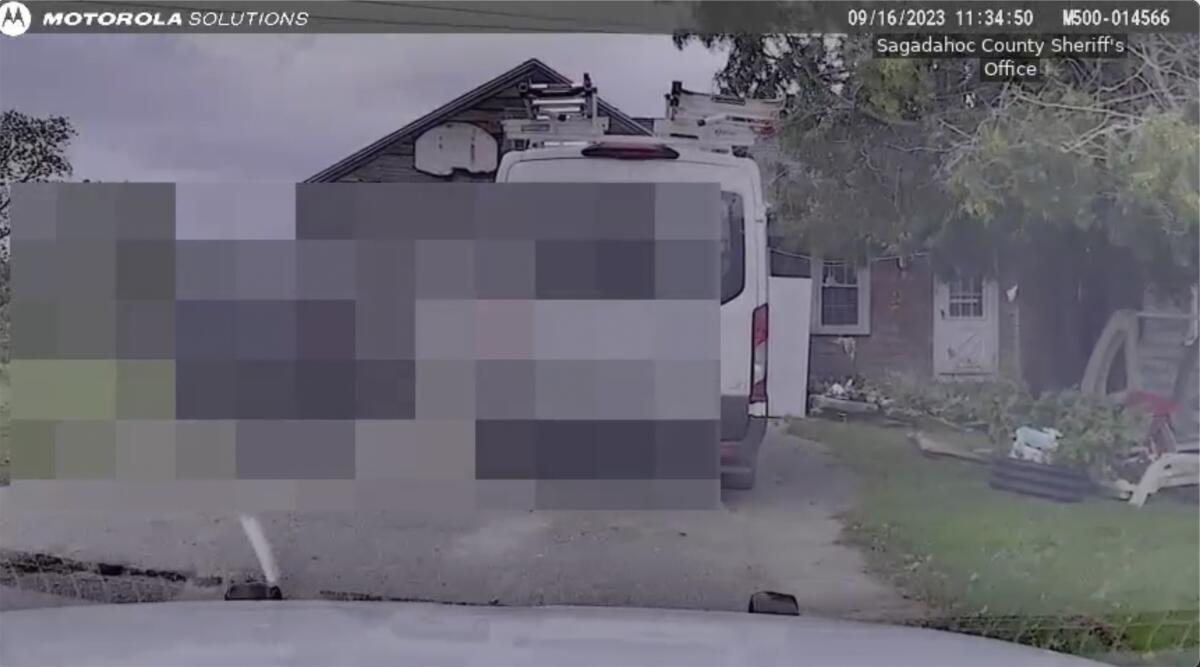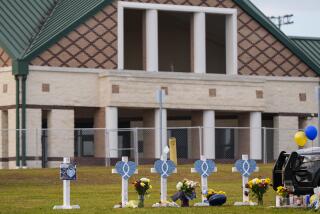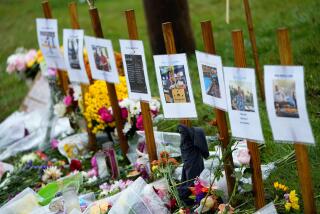Authorities knew Maine shooter was a threat

- Share via
PORTLAND, Maine — Police who declined to confront an Army reservist in the weeks before he killed 18 people in Maine’s deadliest mass shooting feared that doing so would “throw a stick of dynamite on a pool of gas,” according to video released Friday by law enforcement.
The video, which was released to the Portland Press Herald, then sent to the Associated Press, documents a Sept. 16 call between Sagadahoc County Sheriff’s Sgt. Aaron Skolfield and Army Reserve Capt. Jeremy Reamer. Skolfield was following up with Reamer about the potential threat posed by Robert Card, 40, who carried out the Oct. 25 attacks at a bowling alley and a restaurant and was found dead two days later of a self-inflicted gunshot wound.
Military officials alerted police in September that Card had been hospitalized in July after exhibiting erratic behavior while training, that he still had access to weapons and that he had threatened to “shoot up” an Army reserve center in Saco, a city in southern Maine. The sheriff’s department responded by briefly staking out the Saco facility and going to Card’s home in Bowdoin for what Reamer described as a “welfare check.”
“The only thing I would ask is if you could just document it,” Reamer said. “Just say, ‘He was there, he was uncooperative. But we confirmed that he was alive and breathing.’ And then we can go from there. That’s, from my end here, all we’re really looking for.”
Skolfield mentioned Maine’s yellow flag law, which can be used to remove guns from potentially dangerous people, after Reamer said Card had refused medical treatment after his hospitalization.
“So that, obviously, is a hurdle we have to deal with. But at the same time, we don’t want to throw a stick of dynamite on a pool of gas, either — make things worse,” he said.
Reamer expressed similar concerns. “I’m a cop myself,” he said. “Obviously, I don’t want you guys to get hurt or do anything that would put you guys in a compromising position.”
The nation’s high court refuses to decide quickly on Trump’s claim that he cannot be prosecuted for the Jan. 6 attack on the U.S. Capitol.
Auburn City Councilor Leroy Walker Sr., whose son Joseph Walker was killed in the shootings, expressed frustration with police after seeing the video. Joseph Walker was the manager of Schemengees Bar & Grille, one site of the attack.
“I would like to know what we train these people to do. Is it just to deliver mail? Or stop innocent people that may be driving 11 miles [per hour] over the speed limit?” Walker said in a text message, noting that watching the video made him “sick.”
In the video, Skolfield referred to the Cards as “a big family in this area” and said he didn’t want to publicize that police were visiting the home. He told Reamer he would reach out to Card’s brother Ryan to ensure family members had taken Card’s guns, and a second video shows an officer at the father’s home. After Card’s father said he hadn’t spoken with Ryan in several days, the officer said he would try again later.
“I just wanted to make sure Robert doesn’t do anything foolish at all,” he said.
A report released last week by Sagadahoc Sheriff Joel Merry made clear that local law enforcement knew months before the attack that Card’s mental health was deteriorating. Police were aware of reports that he was paranoid, hearing voices, experiencing psychotic episodes and possibly dealing with schizophrenia.
Merry and Lewiston city officials declined to comment on the release of the videos.
But Stephanie Sherman, an attorney who has represented several families of survivors of the 2022 mass shooting at an elementary school in Uvalde, Texas, said the videos show that officers took a disturbingly casual approach to the threat Card posed. Police had more than enough information to take to a local judge, she said.
“There was a history of problems within the Army, there was a history of institutionalization. The police knew that this person was having hallucinations,” Sherman said. “So there was a whole batch of problems that they quickly could have gotten an order to confiscate the guns, and even possibly put the person in custody. Not criminal custody, but some kind of psychiatric hold.”
Sherman said, however, that police tend to rely on immunity, which historically has shielded them from liability when they avoid taking an action such as placing a person in custody.
A former New York Police Department detective sergeant who reviewed the videos for the AP said the events preceding the shooting illustrate the difficulty in applying Maine’s yellow flag law. Lax laws about removing weapons from dangerous people are a problem in numerous states, said Felipe Rodriguez, an adjunct professor at John Jay College of Criminal Justice in New York City.
“The laws are just too convoluted, and they are working against each other. That’s the biggest problem we have,” Rodriguez said.
Dan Flannery, director of the Begun Center for Violence Prevention Research and Education at Case Western Reserve University, cautioned that only so much about a police investigation can be gleaned from a few minutes of video.
“There is always context; there is the issue of what is the training and protocol within the division,” Flannery said. “Violent behavior is unfortunately one of the most difficult things to predict.”
But attorneys for victims’ families said the footage supports a pattern of police ignoring clear warning signs about Card in the weeks prior to the shooting. One of the attorneys, Ben Gideon of Auburn, said, “Watching that footage, knowing what happened approximately six weeks later, is chilling and surreal.”
The attorneys said they are looking forward to an independent Army inspector general’s full accounting of the events leading up to the shootings. Some of the information they’ve gathered so far, including the video released Friday, is “highly concerning,” said Travis Brennan, another attorney for the families.
“It’s one example of many of system failures. There is no question here that this is an individual who had overt warning signs,” Brennan said.
The last patient of 13 who were admitted to Central Maine Medical Center after the shooting has been released, hospital representatives said Friday.
In addition to the inspector general’s investigation, Gov. Janet Mills appointed an an independent commission led by a former state chief justice to review all aspects of the tragedy.
The actions of authorities ahead of and during mass shootings have come under increasing scrutiny. Last year, the Air Force was ordered to pay more than $230 million in damages to survivors and victims’ families for failing to flag a conviction that might have kept the gunman in a 2017 church shooting in Texas from legally buying the weapon he used in the attack.
After a gunman fatally shot 19 children and two teachers at the school in Uvalde, Texas lawmakers issued a scathing report faulting law enforcement at every level with failing “to prioritize saving innocent lives over their own safety.” Several officers lost their jobs over the halting and haphazard response, and a state prosecutor is considering whether to bring criminal charges.
_
More to Read
Sign up for Essential California
The most important California stories and recommendations in your inbox every morning.
You may occasionally receive promotional content from the Los Angeles Times.











